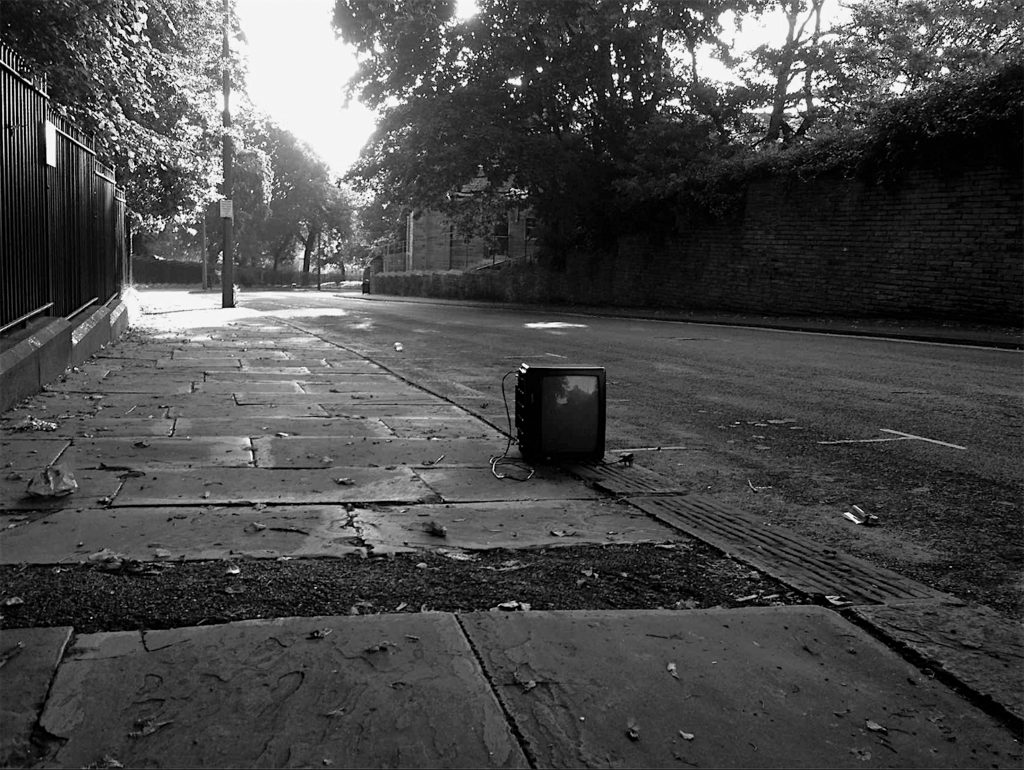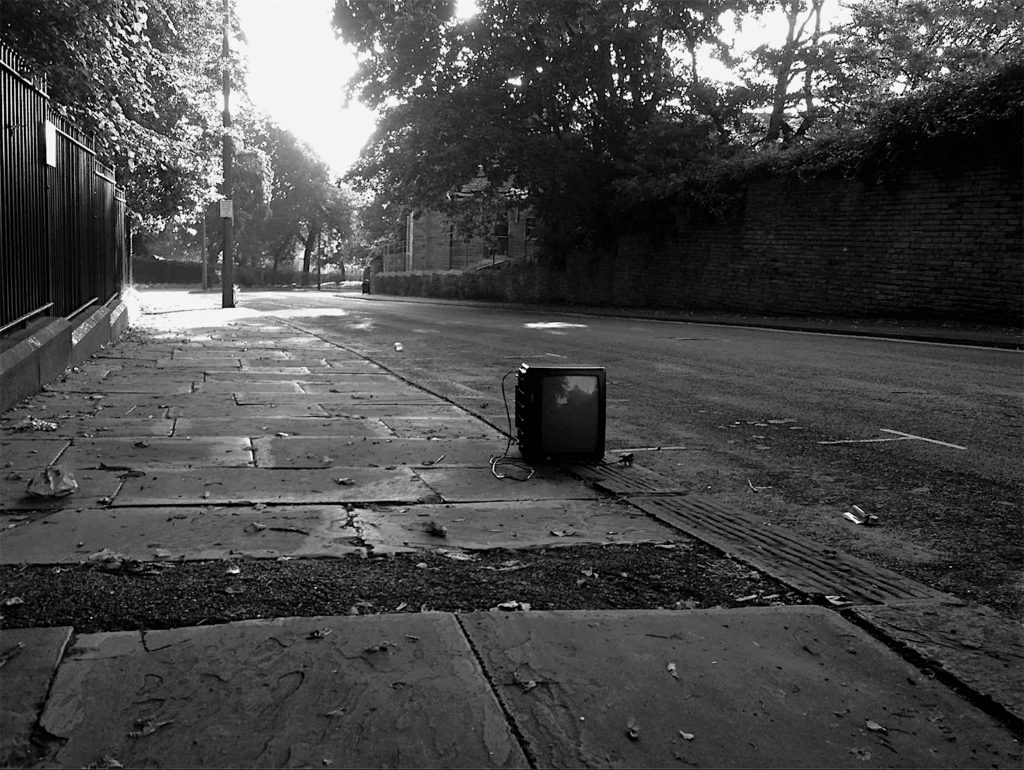 WORDS: Gareth E. Rees reviewing Round About Town, by Kevin Boniface, Uniformbooks 2018
WORDS: Gareth E. Rees reviewing Round About Town, by Kevin Boniface, Uniformbooks 2018
LOCATION: Huddersfield, West Yorkshire
IMAGES: Kevin Boniface from Round About Town
When I lived beside Hackney and Walthamstow Marshes, I was privileged to be a freelance writer who could work from home. It meant that I got to experience the same patch of landscape almost every day on my dog walks. This permitted me a deeply layered, nuanced view of the place. I saw the marshes in every season, in multiple shades of light, in variances in temperature and texture, under every kind of sky, affected by every kind of weather.
Five years of walking the same place allowed me enough time to gather images, stories and impressions. To see patterns in those things left scattered – the drug paraphernalia, the remnants of fox kills, abandoned sleeping bags, lost shoes and fly-tipped office equipment. Daily, consistent walking for five years allowed me to harvest enough experiences that, when condensed into my book, Marshland, brought out the richness and intricacies of the marshes that a few occasional visits wouldn’t achieve. When you are out and about, moving through a landscape every day, you notice things which others might ignore in their haste, or because they’re too deep in conversation. You get a microscopic view. And as with studying the physical world, the closer you look at objects, the weirder they tend to become.
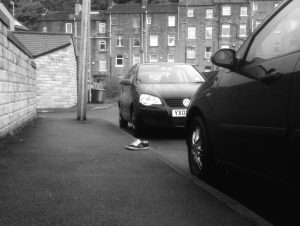 My experience in London sprung to mind when I read Kevin Boniface’s Round About Town, a portrait of Huddersfield as seen by a postman doing his daily rounds. It takes the form of sequential diary entries over a span of eight years. There is that same, dizzying flow of stories – rich, baffling and mysterious – that I experienced walking the marshes.
My experience in London sprung to mind when I read Kevin Boniface’s Round About Town, a portrait of Huddersfield as seen by a postman doing his daily rounds. It takes the form of sequential diary entries over a span of eight years. There is that same, dizzying flow of stories – rich, baffling and mysterious – that I experienced walking the marshes.
Instead of being fixed in a frame like a painting, Huddersfield becomes a fluid entity as a series of images, vignettes, incidents and glimpsed lives flow through every page, endlessly unfolding. Many of these are ‘tip of the iceberg’ narratives which suggests a deeper story.
“Two young men in hooded tops are fastening some blue flashing lights to the roof of a car. They each have an upturned bucket to stand on so they can reach.”
Everyday life is an ongoing farce. In one entry, a red Ford Ka speeds past him. A few paragraphs later, it speeds past him again in the opposite direction. When he sees the Ka a third time, it is half on the pavement with its front wing crashed into a wall. There is no attempt to explain or extrapolate. Boniface observes, writes it down, and then moves on.
The book is full of people doing inexplicable things for instance, “The man who regularly shouts at the top of his voice from the flats at 5.30am was screaming instead this morning.” In another segment, a man is walking down the street ahead of him, wearing a pink Winnie the Pooh duvet.
“Two black Labradors bark at each other from opposite sides of the street while their owners conduct a loud conversation about black Labradors above the noise”.
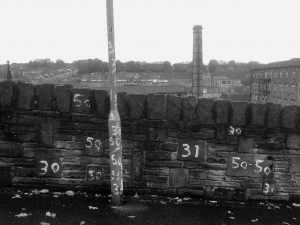 Odd coincidences – or synchronicities – catch his eye. He finds a piece of A4 paper on the street: “It’s the third I’ve found bearing this message in the last six months: ‘Iranian intelligence officers lick English Arse’.” Or there’s his list of places he’s seen the Cross of St George in a single day:
Odd coincidences – or synchronicities – catch his eye. He finds a piece of A4 paper on the street: “It’s the third I’ve found bearing this message in the last six months: ‘Iranian intelligence officers lick English Arse’.” Or there’s his list of places he’s seen the Cross of St George in a single day:
“1. Painted across the bonnet of a white baker’s van. 2. On a flag flying from a dead tree in a garden on Manse Drive. 3. On a flag flying from the Foresters Arms pub. 4. Painted on a drain cover by the back door of a house in Cowlersley. 5. On a flag flying from what used to be The Green Cross real ale pub but it now a Sex Encounter Club with blacked out windows and plans for a sauna.”
The flag links these disparate scenes together to create a peculiar postman’s-eye vision of the town, of Britain itself – dead trees, white vans, drain covers, sex clubs – but without a sense of judgement. The book takes everything as it comes. There is no hierarchy of objects or a sense that certain objects and entities are more picturesque or culturally valid than others.
“On my way into work, I see a bat, an owl, the short woman with the sweat-shirt and the peroxide perm.”
At times, the detailing of the walk, the density of the images, and the sense of cosmic humour at play behind everyday life feels similar to sections of Alan Moore’s Jerusalem. For instance, here’s a line from Moore’s novel: “Human existence is a grand recurrence. Nothing dies or disappears and each discarded condom, every dented bottle-top in every alleyway is as immortal as Shamballah or Olympus…” Boniface makes observations and sees connections but leaves the reader to interpret this grand recurrence of images. In this book life feels small and mundane, but also grand and universal.
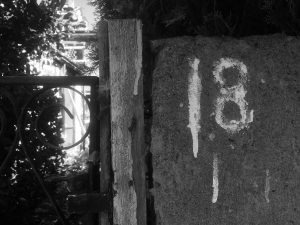 Against a backdrop of the seemingly mundane, there is something lurid, hyperreal and absurd about the town.
Against a backdrop of the seemingly mundane, there is something lurid, hyperreal and absurd about the town.
“A vicar has installed a lurid 3D picture of a blond haired Christ adjacent to the front door of the vicarage.”
There is even Dadaist humour to be found in the streets: “Yesterday there was a house brick wrapped in silver foil and two metal dessert spoons on the bench on Fitzwilliam Street. This morning, the spoons have gone but the house brick is still there.”
Among the many humorous vignettes there is a sadness to scenes which we might ordinarily pass by.
“At the house with the broken satellite dish and an empty Foster’s can in the garden, the front door has been graffitied with a marker pen: inside a wonky love heart it says, ‘I miss you Mum’.”
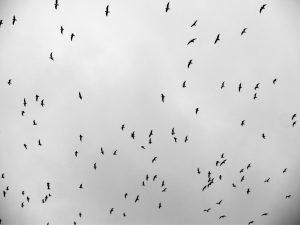 There is also nature of the Richard Mabey kind here – the Unofficial Countryside where plants and animals eke out a living among the estates, canals, pubs and pavements.
There is also nature of the Richard Mabey kind here – the Unofficial Countryside where plants and animals eke out a living among the estates, canals, pubs and pavements.
“A heron flies over Shangri-La, a blackbird picks up a sun-baked slug and bounces it on the driveway at the Orchard House and, at Greenside, where the man with the pickaxe says he’ll be ok as long as it stays dry, a robin is eating some shat-out berries on top of a gate post.”
In another scene what Boniface thinks is a plastic ornamental heron turns out to be a real one, which flaps away as he approaches. Sometimes the kitsch and the real are hard to separate. The artificial and the natural are intertwined in the streets of Huddersfield. This is a wonky, odd, occasionally bleak England, but also one full of heart and humour, in which life is just trying to get by.
Round About Town by Kevin Boniface is Available from Uniformbooks – you can visit their website here
 ABOUT THE AUTHOR
ABOUT THE AUTHOR
Gareth E. Rees is the author of Car Park Life out soon on Influx Press
‘A retail park Heart of Darkness.’
– John Grindrod, author of Outskirts
‘There’s no shortage of books nowadays seeking out the hidden corners of our towns and cities, but few set themselves the challenge of exploring seemingly such unpromising terrain as Car Park Life. Against the odds, Gareth Rees succeeds brilliantly in illuminating these neglected spaces and in bringing their unexpected stories to life.’
– Merlin Coverley, author of The Art of Wandering
‘Drives all over the psychogeography genre, and leaves the bodies buried beneath the tarmac.’
– Owen Booth, author of What We’re Teaching Our Sons

